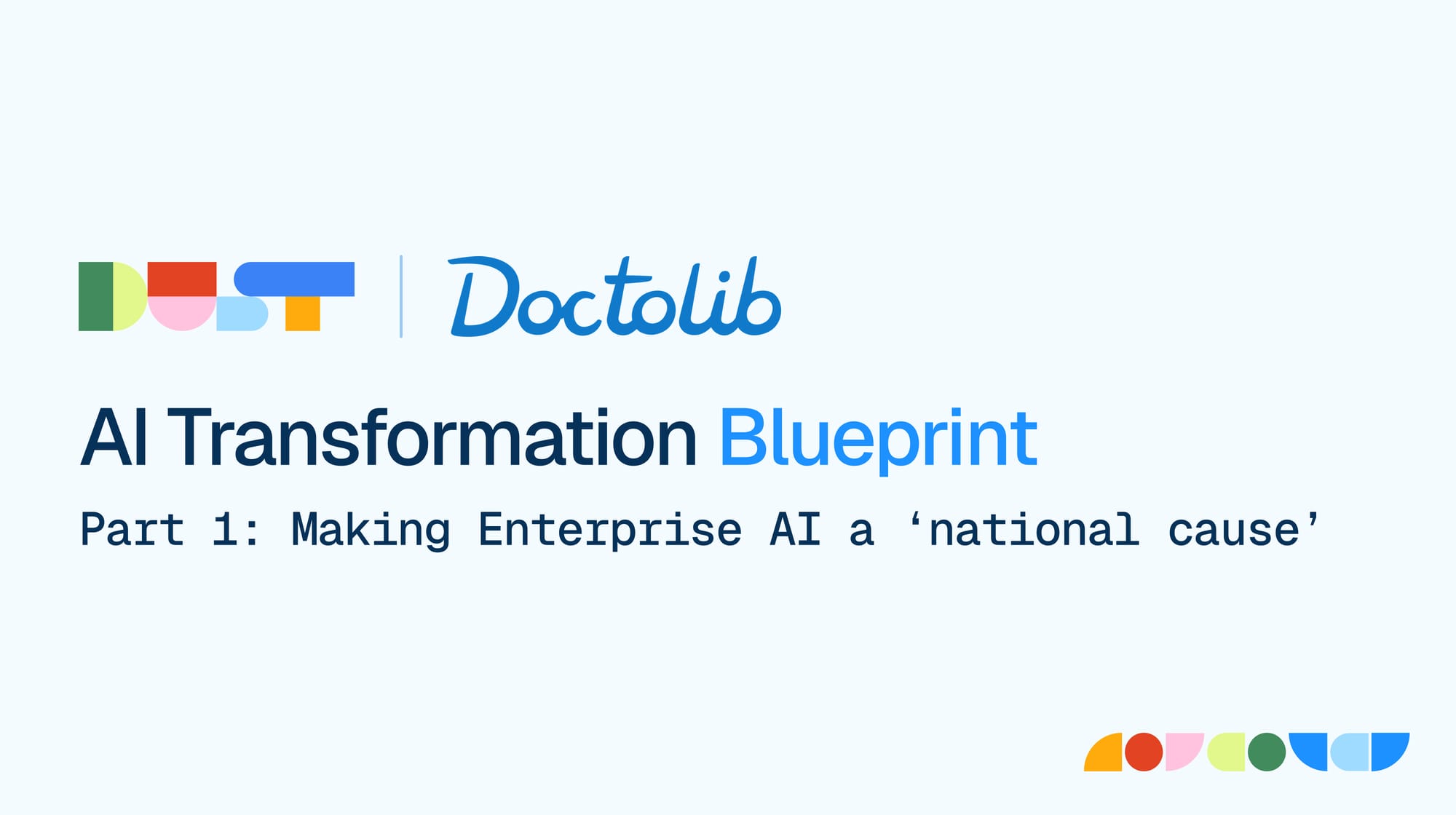Why Doctolib made company-wide Enterprise AI a 'national cause'

This is the first article in a four-part series exploring how Doctolib successfully rolled out Dust across 3,000 employees, covering everything from cultural transformation and strategic decision-making to security implementation and tactical execution. This piece explains why their C-suite decided to make AI company-wide adoption a strategic priority.
- WHO: C-level Leaders planning organization-wide AI transformation
- PAIN: Companies struggling with AI adoption beyond pilot programs. Learn how Doctolib treated it as a cultural change, not just tool deployment.
- PAYOFF: Learn how Doctolib achieved 70% weekly (30% daily) usage across 3,000 employees in 6 months through strategic cultural transformation
"We positioned AI transformation as an imperative rather than optional innovation," explains Matthieu Birach, Chief People Officer at Doctolib. Six months after company-wide deployment, the results speak for themselves: 70% weekly usage (30% daily) usage across 3,000 employees, 45% would be "very disappointed" to lose access, and a cultural shift that's energizing their workforce.
But getting there required treating AI as what Matthieu calls a 'national cause'—a fundamental transformation of how work gets done, not just a new tool rollout.
Why AI Became Doctolib's 'National Cause'
For Doctolib, AI transformation wasn't about optimization—it was about deep cultural transformation. Leadership identified three critical drivers:
- Business Competitiveness: "Essential for competing in the evolving market. The ones who lag will be late."
- Talent Attraction: "Top performers gravitate toward AI-forward environments."
- Strategic Alignment: "We can't ask users to embrace AI if we don't embrace it ourselves."
"This needed to happen fast. It will take time to drive change, and many tools are black boxes and don't allow teams to really deploy & learn AI." — Matthieu Birach, CPO
This insight shaped their platform choice: they needed a solution that would build AI literacy, not just AI usage.
Doctolib's Three-Phase Transformation Approach
Doctolib identified three phases with parallel tracks to maximize both adoption and impact:
- Phase 1: Democratization - "No need to be technical to embrace AI"
- Phase 2: AI-first Mindset - Teams asking "Could AI help with this? Could we build this ourselves?"
- Phase 3: Industrialization - "Focus on ROI and systematic deployment"
The Two-Track Strategy
Doctolib's framework relied on providing basic AI for all, while gradually developing vertical use cases by waves.
Track 1: Horizontal Productivity AI
- Broad accessibility across all roles
- Focus on eliminating time waste on basic tasks
Track 2: Vertical High-Value Use Cases
- Targeted, high-impact applications in specific departments
- Intensive change management required
Universal Deployment: The Network Effect
The problem with selective deployment: Partial rollouts create two classes of workers—the AI-enabled and the traditional.
Doctolib's insight: Universal adoption creates network effects. Because Dust's workspace architecture allows agents to be shared across teams, employees from all departments can learn from each other's approaches, and compound organizational intelligence—something impossible with siloed AI tools.
Concrete results:
- Knowledge sharing: Technical Services champions adapted their successful customer support agents for other teams
- Cross-pollination: AI best practices and expertise spread organically across departments
- Reduced redundancy: Eliminated duplicate AI investments through consolidation of tools
Building AI Literacy Through Practice
Doctolib needed something that gets people into the habit of using AI and helps them understand AI capabilities through hands-on experience. Dust's no-code agent builder meant non-technical employees could create sophisticated workflows with limited IT support, accelerating the builder mindset across all departments.
Real examples of literacy building:
- People hackathons: Cross-functional teams built recruitment and HR agents, learning AI capabilities through hands-on problem-solving
- Organic agent creation: 20% of employees have built their own agents.
- Cross-team knowledge transfer: Successful agents spread from department to department with teams understanding how they worked
"Teams are becoming more creative and builder-oriented. Employee engagement is rising as AI adoption energizes them." — Matthieu Birach, CPO
The CEO Playbook for AI Cultural Transformation
1. Go Universal, Not Selective
AI transformation takes time—partial rollouts create second-class employees and delay organizational learning.
2. Choose Collaborative Platforms
Community and cross-team sharing—propagate knowledge and AI expertise, build use cases with the same platform.
3. Make It a Strategic Priority
Doctolib made it a strategic priority—an event, a keynote—an important moment in the company life. Empowering senior executives with AI knowledge and transforming them into advocates was instrumental for adoption.
4. Combine IT and People Expertise
"We really broke down silos between IT and People teams to work together on a project with significant weight."
5. Address Resistance Head-On
"There won't be going back on AI, that's how it is, but we need to accompany people in the change."
Current Results and Future Vision
Measurable Impact (6 months)
- 30% daily (70% weekly) usage across 3,000 employees
- 45% would be "very disappointed" to lose access
- Smoother access to corporate information & decommissioned intranet tools
- Cultural shift: Teams becoming more creative and builder-oriented
The Strategic Shift: From Optional to Essential
"We're gradually moving from incentivizing adoption to making it a requirement." Alex Kaluzny, CTO
This means:
- Hiring evolution: AI fluency becomes a core competency
- Career development: "Systems thinking"—the ability to identify where and how to apply AI—becomes as fundamental as digital literacy
- Competitive advantage: Employees who are given cutting-edge AI capabilities will be radically more effective. Top performers will expect access to an AI-first stack.
Three Questions Every People Leader Must Answer
- How do we redesign work? Move beyond "AI as nice-to-have" to an AI-first mindset.
- What skills matter now? "Systems thinking" and "shot selection—choosing the right solution (AI or not) for each problem" become core competencies.
- How do we compete for talent? Top performers want to work where they can be most effective with cutting-edge tools.
The Bottom Line
Doctolib's experience shows that treating AI as a "national cause" worked better for them than fragmented departmental tool rollouts. Their approach—universal deployment, collaborative platforms, and focusing on cultural change—built organizational capabilities that improve over time.
Key Takeaway: Cultural transformation requires the right technical foundation. Doctolib's success came from choosing a platform that enabled both immediate experimentation and long-term sophistication as teams matured their AI capabilities.
Coming up: Part 2 examines VP of Data & AI Nacim Rahal's critical build vs. buy decision that enabled this transformation.

